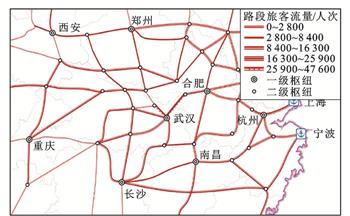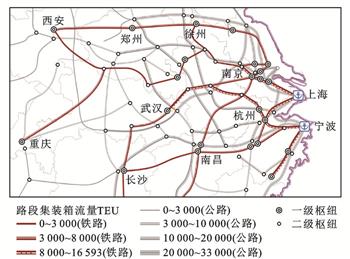| 基于铁路货运能力的集港集装箱班列组织优化 |
| |
| 引用本文: | 连峰, 杜怡颖, 杨忠振. 基于铁路货运能力的集港集装箱班列组织优化[J]. 交通运输工程学报, 2022, 22(2): 277-286. doi: 10.19818/j.cnki.1671-1637.2022.02.022 |
| |
| 作者姓名: | 连峰 杜怡颖 杨忠振 |
| |
| 作者单位: | 宁波大学 海运学院,宁波 浙江 315211 |
| |
| 基金项目: | 国家自然科学基金项目72072097 |
| |
| 摘 要: | 
基于大数据挖掘的方法估算了铁路车站间OD客流,调查分析了铁路乘客对高铁和普铁的选择偏好,确定了高铁开通后普铁线路客运的供需关系与均衡,把普铁线路上的客流转换成相应的旅客列车列数,以此计量客运占用的普铁的通过能力;评估了各普铁路段的总通过能力,基于扣除系数法计算普铁各路段剩余的货运能力,并进一步在普铁线网上根据集装箱进港量确定集装箱班列枢纽站的候选集;将候选枢纽站的班列发车频率作为离散的内生变量,基于现实中的干线公路网络和普铁网络构建枢纽站选址和发班频率优化模型,求解模型,确定集装箱铁路集港服务网络的经济技术指标;以上海港和宁波港及其腹地为案例进行数值分析。计算结果表明:在案例的空间范围内的普铁运输线上,日均通过能力最小为79列,最大为137列;基于普铁各路段剩余的货运能力,计算得出各集装箱班列枢纽站的日均发班频率最小为6列,最大为19列;由计算得到的普铁路段上的流量可以看出,铁路运送到上海港和宁波港的日均集装箱量分别为13 677、12 094 TEU,分别占2个港口日均到达总量的25%和33%,相比目前占比5%~7%有大幅度增加。

|
| 关 键 词: | 铁路运输 货运能力 集装箱运输 网络优化 用户均衡 发班频率 |
| 收稿时间: | 2021-11-03 |
|
| 点击此处可从《交通运输工程学报》浏览原始摘要信息 |
|
点击此处可从《交通运输工程学报》下载免费的PDF全文 |
|


